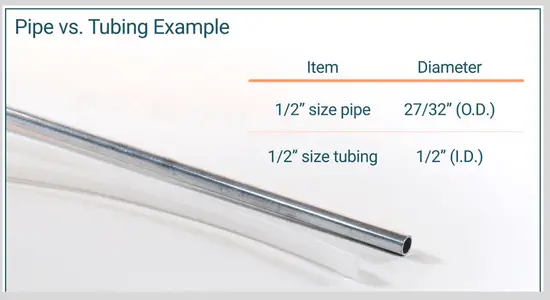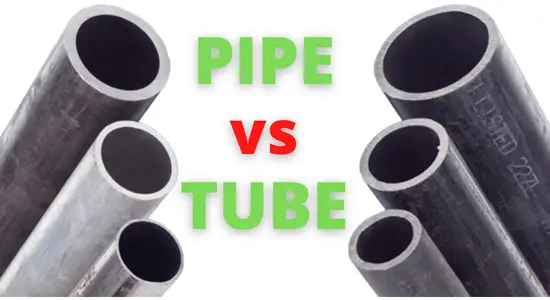Pipe and Tube – Two different words for two different things! People often use the two words interchangeably. However, there exists a significant difference between the two in terms of their terminology, sizes, shapes, manufacture, etc.
A tube is a long tubular used to carry fluids, compress gases, and pressure, and can be used as a heat exchanger. It comes in different shapes like round, rectangle, oval, square, etc. However, the pipe is a round tubular that distributes gasses and fluids.
Want to learn more about the two? Then quickly grasp a cup of tea, and without further ado, jump to the next section!
What is a Pipe?
A pipe is a long tubular, hollow cross-section. It conveys things like power fluids, liquids, and gasses without any sample loss or contact with contamination.
It is measured in terms of its nominal pipe size and diameter. It is always round and rigid, making it hard to be hammered and bent.
What is a Tube?
When eyeing the tube specifically, it is a long hollow tubular which comes in different shapes and sizes, like round, rectangular, square, etc.
It is used not only to carry fluids but is of great importance in pressure and mechanical applications. It is designed and measured in terms of its outer diameter and wall thickness.
Pipe vs Tube: Key Factors That Matter
| Factors | Pipe | Tube |
| Strength | Less strong | More sturdy than pipe |
| Dimensions (Measurements) | Based on inner diameter | Based on outer diameter and wall thickness |
| Material for production | Low alloy steel Carbon steel | Steel, aluminum, brass, copper, etc. |
| Ends (Connections) | Plain, beveled, or screwed | Threaded or Grooved |
| Tolerance | Rigid | Flexible |
| Shape | Round | Rectangular, oval, round, etc. |
Pipe Vs Tube – The Main Differences In Details
Now that we have gained general know-how of pipe and tube let’s compare the two and learn the difference!
- Pipe vs. Tube Strength
When comparing the strength of pipe and tubes, the tube definitely wins the crown. The reason is that tubes are used for heat and pressure exchangers, etc.
So, it needs to be made with materials having a high level of tolerance. Moreover, it undergoes various quality tests to check its mechanical strength. However, pipes have a fixed tolerance level.
- Pipe vs. Tube Size and Units
This is counted as one of the prime differences between the two. A pipe is expressed in terms of its inner diameter, which defines the amount of volume carried by it, and schedule, which stands for the wall thickness of the pipe like Sch.40, Sch.STANDARD, etc.
On the other hand, a tube is measured relative to its outer diameter and wall thickness, which are expressed in units of inches and millimeters.
- Pipe vs. Tube Bender
Pipes are comparatively more rigid. They are thick-walled and hence can’t be easily hammered or shaped using a bender.
However, a tube is thin-walled and can be bent into different shapes as needed using a tube bender. Less stress is required to turn a tube.
Usually, a bender is used to change the shapes. You can’t use the tube bender to bend your pipe, as it is designed to apply optimal stress for the thin-walled tubes only.
However, a pipe bender can turn tubes too.
- Pipe vs. Tube Applications
Pipes are used mostly to carry different types of fluids and gas. However, tubes have far more extensive applications.
They are used in heat exchangers, fired heaters, tracing lines, etc. In fact, it is counted as one of the members of primary load-bearing instruments.
- Pipe vs. Tube Production
Tubes are produced in small amounts at a time, while pipes are made in stocks on a large scale. The reason is that tubes must undergo and fit various small cumbersome ácriteria.
- Pipe vs. Tube Chemical Makeup and material
When considering the elements that combine to make pipe, mostly carbon steel and low steel alloy are used. The elements used in its manufacture are Carbon, sulfur, manganese, silicon, and phosphorus.
However, elements small in size are used to offer compact packing. They come in several materials like aluminum, brass, steel, chrome, copper, etc.
- Pipe vs. Tube Price
Tubes are comparatively more expensive than pipes because of their strict inspections, high tolerance, and productivity.
How to Measure Tubes and Pipes?

Measuring the correct size of tubes and pipes is very important. Only then can you buy the desired pipe and tube.
So, to measure the size of a male or female pipe:
- Wrap a thread around the pipe. For the male pipe, wrap the thread on the outer side, while for the female pipe, wrap the yarn on the inner side.
- Measure the circumference, and divide it by 3.142. You will get the diameter
- This diameter is called Nominal Diameter and is used to buy the required pipe.
However, in the case of tubing, no such fuss is required. All you need to do is to measure the outer diameter, and here you go!

Frequently Asked Questions (FAQs): Pipe vs Tube
What is the main difference when measuring pipe and tubing?
The main difference between measuring pipe and tubing is that in pipes, we measure the inner diameter, while in tubing, we look for the outer diameter.
Is pipe size ID or OD?
The nominal pipe size is based on inner diameter (ID). It means if a pipe has a 1.5-inch nominal diameter, it means it is 1.5 inches wide from the inside.
What advantage does a tube have over a pipe?
There are various advantages of a tube over a pipe, like they are light yet more sturdy, precise with no pressure drop, flexible, and have fewer chances of leakage. Moreover, it required no thread sealant for assemblage or for joining two.
Is PVC a pipe or tube?
PVC is a Pipe that is used in various daily life applications like plumbing, sewage, drainage, etc.
Video Info: The Difference Between Pipe and Tube
Conclusion
All in all, pipes and tubes are two completely different things that are often confused as one. Tubes are more costly, are more sturdy, and come in different shapes.
On the other hand, pipes are round tubular sections that are comparatively thicker and more rigid.
However, before buying a pipe or tube, you must know the exact size you want. So, use the above instructions, and get the desired tubing you long for!

